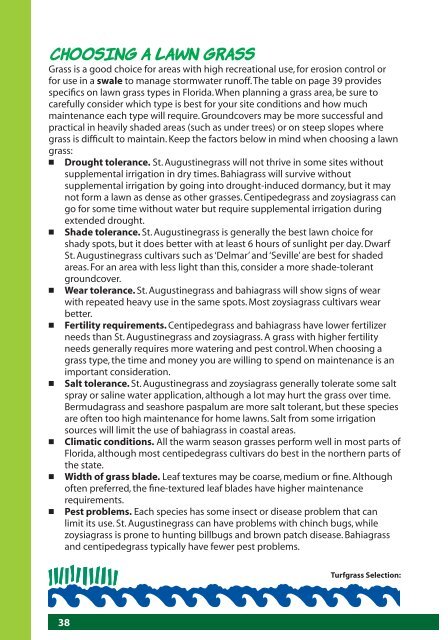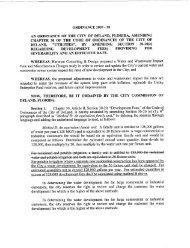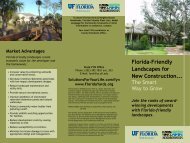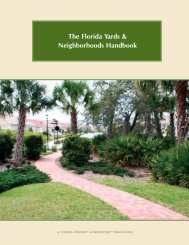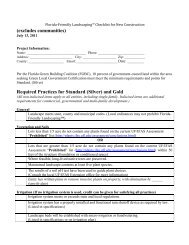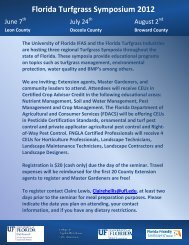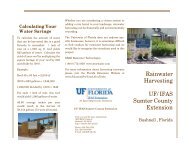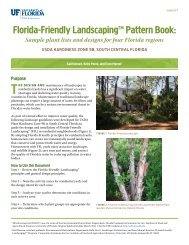A Guide to Florida-Friendly Landscaping A Guide to Florida-Fr ...
A Guide to Florida-Friendly Landscaping A Guide to Florida-Fr ...
A Guide to Florida-Friendly Landscaping A Guide to Florida-Fr ...
Create successful ePaper yourself
Turn your PDF publications into a flip-book with our unique Google optimized e-Paper software.
CHOOSING A LAWN GRASS<br />
Grass is a good choice for areas with high recreational use, for erosion control or<br />
for use in a swale <strong>to</strong> manage s<strong>to</strong>rmwater runoff. The table on page 39 provides<br />
specifics on lawn grass types in <strong>Florida</strong>. When planning a grass area, be sure <strong>to</strong><br />
carefully consider which type is best for your site conditions and how much<br />
maintenance each type will require. Groundcovers may be more successful and<br />
practical in heavily shaded areas (such as under trees) or on steep slopes where<br />
grass is difficult <strong>to</strong> maintain. Keep the fac<strong>to</strong>rs below in mind when choosing a lawn<br />
grass:<br />
■ Drought <strong>to</strong>lerance. St. Augustinegrass will not thrive in some sites without<br />
supplemental irrigation in dry times. Bahiagrass will survive without<br />
supplemental irrigation by going in<strong>to</strong> drought-induced dormancy, but it may<br />
not form a lawn as dense as other grasses. Centipedegrass and zoysiagrass can<br />
go for some time without water but require supplemental irrigation during<br />
extended drought.<br />
■<br />
■<br />
■<br />
Shade <strong>to</strong>lerance. St. Augustinegrass is generally the best lawn choice for<br />
shady spots, but it does better with at least 6 hours of sunlight per day. Dwarf<br />
St. Augustinegrass cultivars such as ‘Delmar’ and ‘Seville’ are best for shaded<br />
areas. For an area with less light than this, consider a more shade-<strong>to</strong>lerant<br />
groundcover.<br />
Wear <strong>to</strong>lerance. St. Augustinegrass and bahiagrass will show signs of wear<br />
with repeated heavy use in the same spots. Most zoysiagrass cultivars wear<br />
better.<br />
Fertility requirements. Centipedegrass and bahiagrass have lower fertilizer<br />
needs than St. Augustinegrass and zoysiagrass. A grass with higher fertility<br />
needs generally requires more watering and pest control. When choosing a<br />
grass type, the time and money you are willing <strong>to</strong> spend on maintenance is an<br />
important consideration.<br />
■Salt <strong>to</strong>lerance. St. Augustinegrass and zoysiagrass generally <strong>to</strong>lerate some salt<br />
spray or saline water application, although a lot may hurt the grass over time.<br />
Bermudagrass and seashore paspalum are more salt <strong>to</strong>lerant, but these species<br />
are often <strong>to</strong>o high maintenance for home lawns. Salt from some irrigation<br />
sources will limit the use of bahiagrass in coastal areas.<br />
■<br />
■<br />
■<br />
Climatic conditions. All the warm season grasses perform well in most parts of<br />
<strong>Florida</strong>, although most centipedegrass cultivars do best in the northern parts of<br />
the state.<br />
Width of grass blade. Leaf textures may be coarse, medium or fine. Although<br />
often preferred, the fine-textured leaf blades have higher maintenance<br />
requirements.<br />
Pest problems. Each species has some insect or disease problem that can<br />
limit its use. St. Augustinegrass can have problems with chinch bugs, while<br />
zoysiagrass is prone <strong>to</strong> hunting billbugs and brown patch disease. Bahiagrass<br />
and centipedegrass typically have fewer pest problems.<br />
Turfgrass Selection:<br />
38


